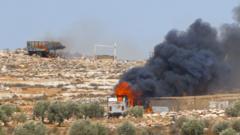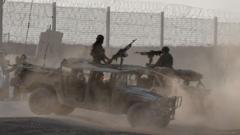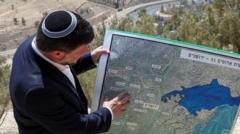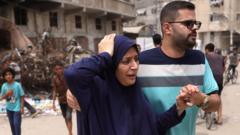Gaza's rubble, contaminated with asbestos, threatens long-term health implications for its population, as immediate dangers overshadow awareness.
**Asbestos in Gaza's Ruins: A Hidden Health Crisis Unfolds**
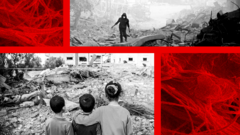
**Asbestos in Gaza's Ruins: A Hidden Health Crisis Unfolds**
The military campaign in Gaza leads to concerns over asbestos exposure amidst ongoing violence.
Israel's ongoing military operations in Gaza have resulted in the release of a deadly environmental hazard: asbestos. Once commonly utilized in construction, asbestos is recognized for its ability to release toxic fibers into the air, which can remain in the lungs and over decades could lead to cancer. Although the use of asbestos is banned in many nations today, older buildings, particularly in Gaza's urban refugee camps, still contain this dangerous material.
According to the United Nations Environment Programme (UNEP), an estimation from October 2024 indicated that approximately 2.3 million tons of rubble in the region may be contaminated with asbestos. Professor Bill Cookson, the director of the National Centre for Mesothelioma Research in London, described Gaza's rubble as a "very, very toxic environment," warning that the implications will extend beyond immediate suffering to long-term health issues for future generations.
Asbestos fibers, invisible to the naked eye, become airborne when disturbed by impacts such as airstrikes. Those living nearby can easily inhale these particles, which can then infiltrate the lungs and induce scarring that may lead to serious conditions like asbestosis or even malignant mesothelioma, a progressive and painful cancer. Prof. Cookson emphasized that even minimal exposure to asbestos can significantly increase the risk of developing these severe illnesses, complicating the scenario in Gaza.
Dr. Ryan Hoy, whose studies regarding dust inhalation have been referenced by UNEP, noted the complexity of avoiding asbestos fibers as they are minute and can penetrate deep into the lungs, particularly in a densely populated area like Gaza, which houses around 2.1 million people within a relatively small space.
Experts working in Gaza reported a troubling lack of awareness about the dangers of asbestos and dust inhalation. Chiara Lodi, a medical coordinator for the NGO Medical Aid for Palestinians, highlighted that the immediate threats of military action overshadow concerns about asbestos exposure. This lack of awareness, coupled with the challenges of everyday survival in such a tumultuous environment, prevents the local population from taking necessary precautions.
Previous studies, such as a UN survey conducted after the 2009 conflict in Gaza, found asbestos in various forms of rubble from older structures. Asbestos types vary significantly, from the less dangerous "white asbestos" to the highly carcinogenic "blue" or crocidolite asbestos, which was previously identified in Gaza by UN assessments.
Globally, 68 countries have enacted bans on asbestos use, although some maintain exceptions for specific applications. Israel prohibited its use in construction in 2011 while the UK banned asbestos in 1999. Alongside mesothelioma, exposure to asbestos has been linked to other cancers including lung and ovarian cancers.
Dr. Hoy warned that the severe levels of dust in Gaza could escalate the risks for respiratory infections and other chronic lung diseases, exacerbating pre-existing conditions within the already vulnerable population. Health experts often reference the consequences of toxic dust clouds from events like the 9/11 attacks in New York as cautionary examples, revealing the potential for long-term health crises following exposure to similar environmental hazards.
As reconstruction plans for Gaza are formulated by a coalition of US and Arab states, the UN stresses the necessity of managing debris removal carefully to prevent disturbing the asbestos-laden rubble. This demolition process presents a dual challenge: while the need for rebuilding is urgent, the removal of contaminated debris could exacerbate asbestos exposure risks.
In the wake of the military offensive initiated in response to a Hamas attack that resulted in numerous civilian casualties, the death toll in Gaza has soared. Estimates indicate that over 53,000 Palestinians, primarily women and children, have lost their lives since the onset of military operations. As health experts uplift the importance of addressing both immediate and long-term health dilemmas in Gaza, the need for thorough measures against asbestos exposure becomes ever more critical.







